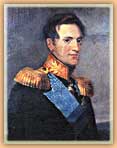 |

More than one year after the naval Battle of Navarino, and
while the Ottoman Empire was involved in a new war with Russia, the three Great Powers continued deliberations on the terms of settlement of the Greek question. The regions that would be included in the
future Greek state
were the main areas of concern.
The result of these deliberations was a series of protocols which were signed in London between the end of 1828 to the beginning of 1830,
when the Ottoman Empire was obliged to accept the decisions of the Great Powers on the creation of an independent Greek state as a result of its
defeat by Russia.
From September 1828 the ambassadors of Great Britain, France and Russia
were holding counsel at Porus in order to decide on the frontiers of the new Greek state.
Their suggestion was made after taking into account, to a certain extent,
the claims of the Greek side, as these were expressed in the memorials
that Kapodistrias had sent on 11/23 September and 30 October/11 November. Thus, they suggested that the Greek territory should include
the regions of Central Greece situated south of the borderline
running from the Gulf of Amvrakikos in the west to the Pagasitikos Gulf in the east.
Despite this decision and as the conference at Porus was not yet completed
the British Minister of Foreign Affairs and the ambassadors of the other two countries were signing a protocol in London. This protocol (4/16 November 1828) excluded Central Greece from the Greek territory.
The frontiers of the new Greek state that were in formation included only
the Peloponnese and the Cyclades.
However, some months later, the propositions of the conference of the three ambassadors at Porus were accepted. The frontier line Amvrakikos-Pagasitikos was adopted by the Great Powers in the Protocol of 10/22 March 1829, which was signed in London. Crete was not included in the Greek territory. In September of the same year, the Ottoman Empire was obliged to accept this protocol, in the context of capitulating with Russia (Treaty of Andrianople).
In the beginning of the following year, specifically on 22 January/3 February 1830 the three Great Powers proceeded with the signing of a new protocol, again in London, which is known as the Treaty of London for Greek Independence. It was the first official international act which acknowledged Greece as an independent sovereign state and not a state obliged to pay tribute to the Ottoman Empire.
This important decision was accompanied by the definition of a new borderline. The regions between the River Achelous in the west and Sperchios in the east were included in the territory of the new state. In this way, the neighbouring of the western regions of Aetolia and Acarnania with Lefkas, which was under British rule, as the rest of the Ionian Islands, was prevented.
On the other side, the Greek state was given the Sporades and Euboea.
Finally, in the Treaty of Independence, Great Britain, France and Russia agreed on the nomination of Leopold Duke of Saxe-Coburg as prince of the
Greek state. However, neither of these decisions were definitive, either in terms of frontiers or in terms of persons and the title of the prince.
The final settlement of the Greek cause was to come one and a half year
later, at the end of August 1832.
|
 |